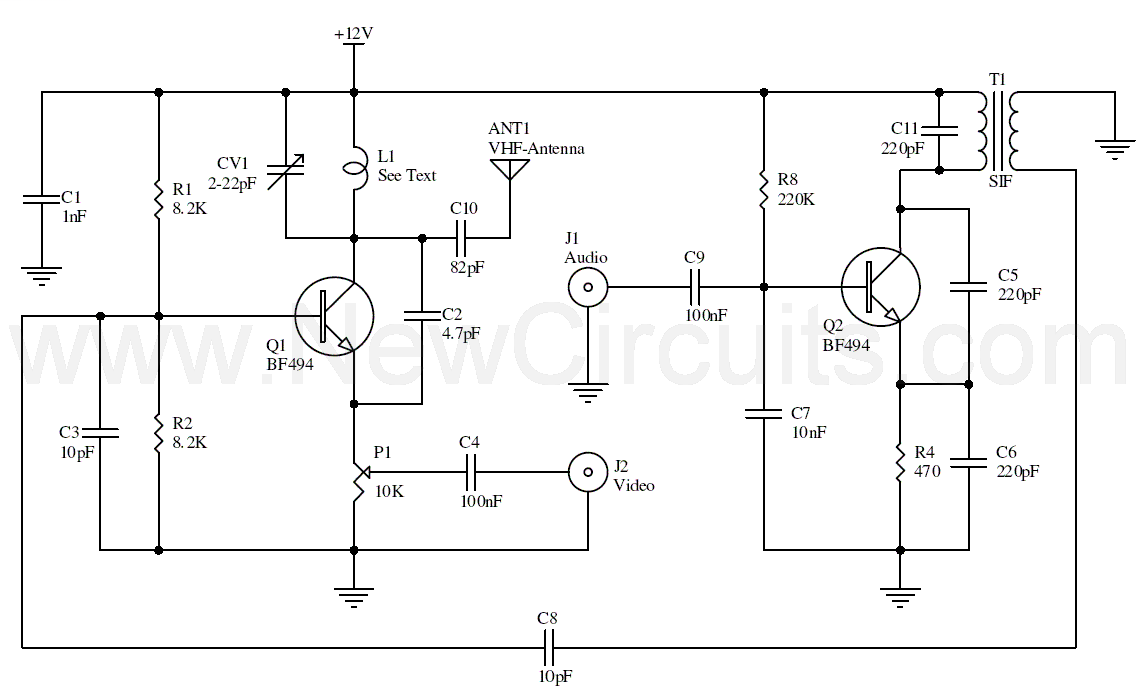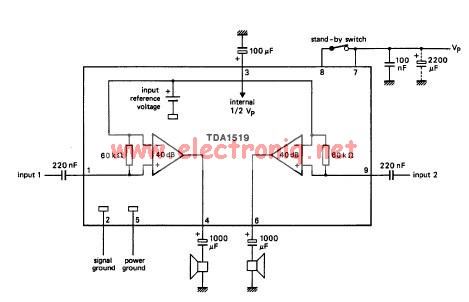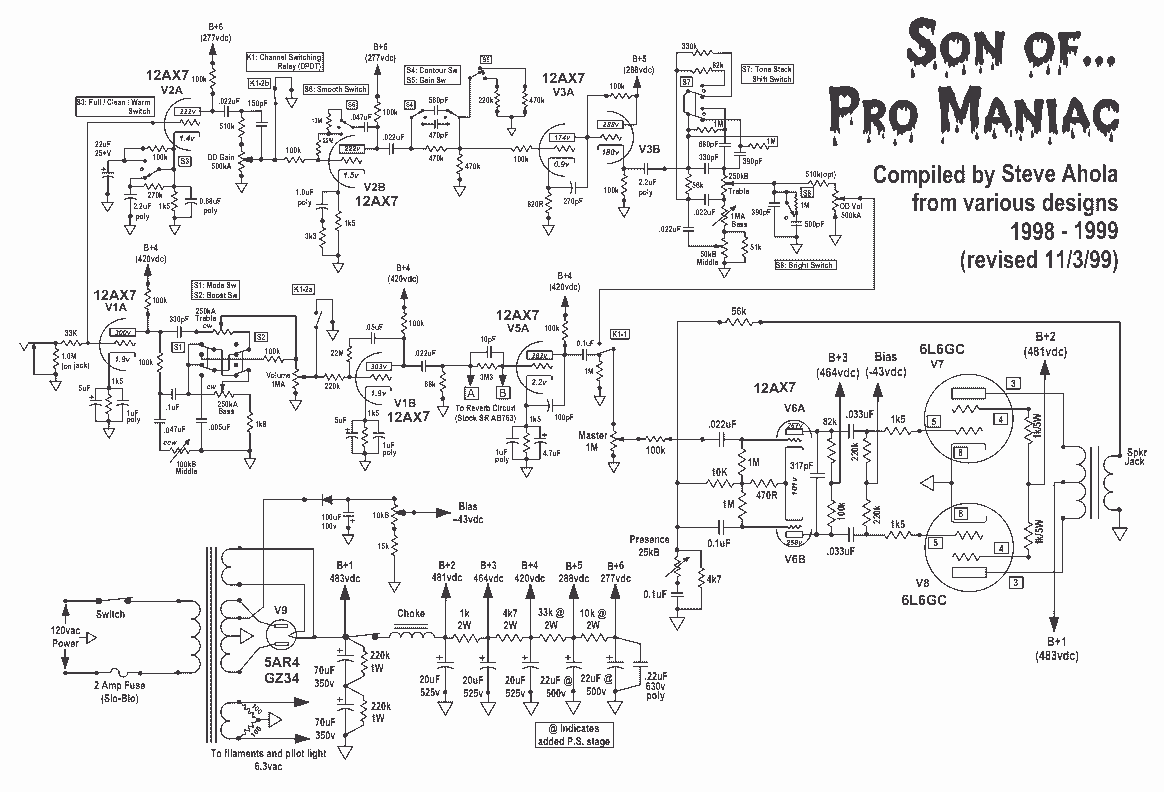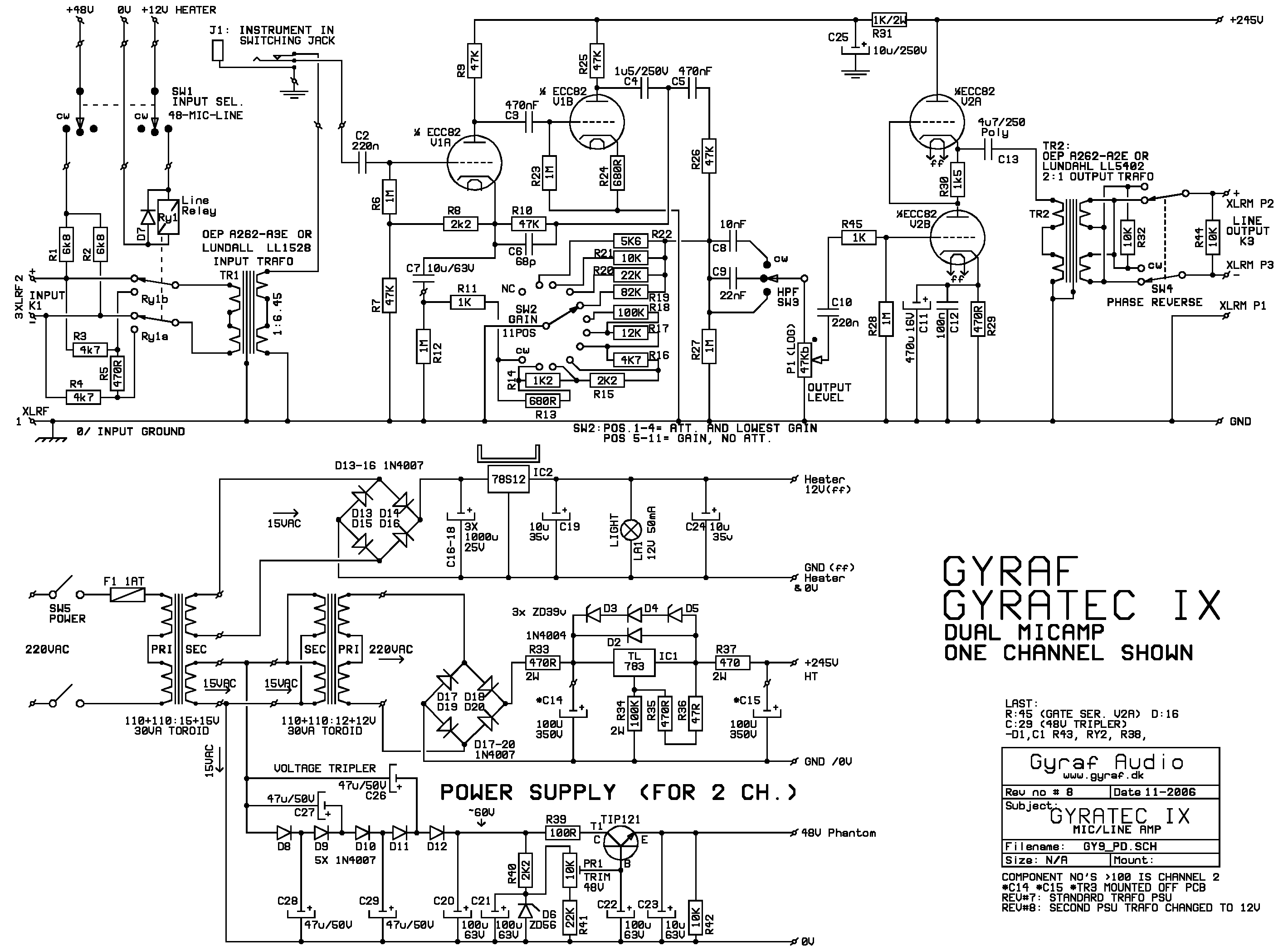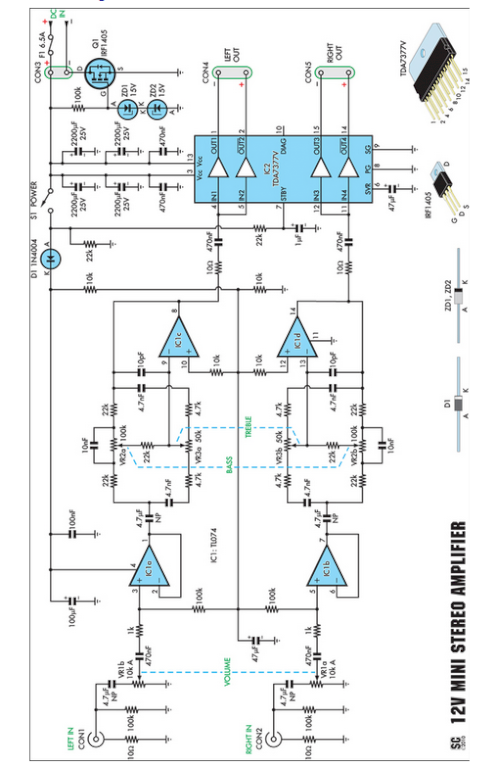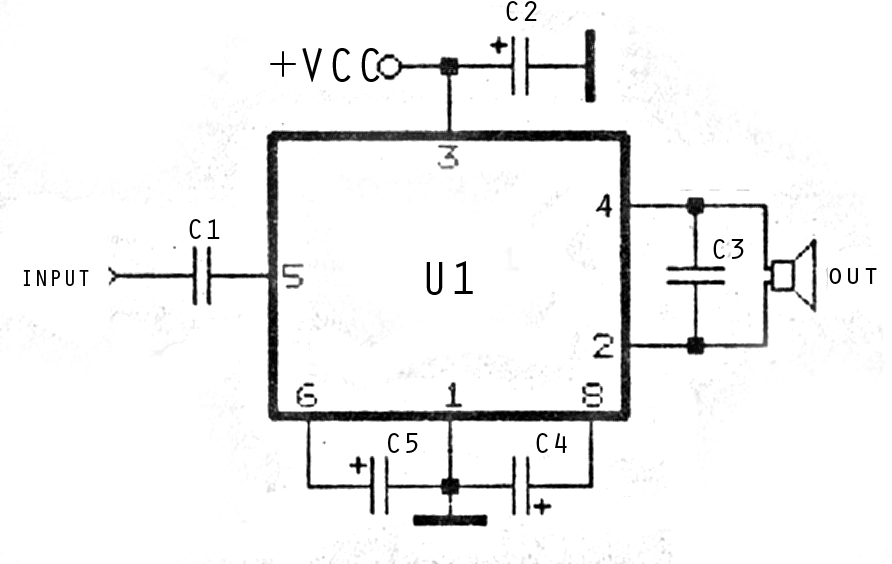
Mini-MosFet Audio Amplifier
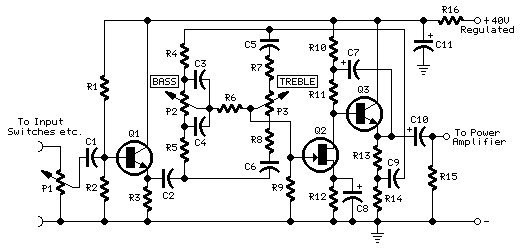
R1 2.2K 1/4W Resistor, R2 27K 1/4W Resistor, R3, R4 2.2K 1/2W Trimmers (Cermet or Carbon), R5 100R 1/4W Resistor, R6 1K 1/4W Resistor, R7, R8 330R 1/4W Resistors, C1 22 µF 25V Electrolytic Capacitor, C2 47pF 63V Polystyrene or Ceramic Capacitor, C3, C4 100 µF 50V Electrolytic Capacitors, C5 2200 µF 50V Electrolytic Capacitor, Q1 BC550C 45V 100mA Low Noise High Gain NPN Transistor, Q2 IRF530 100V 14A N-Channel Hexfet Transistor (or MTP12N10), Q3 IRF9530 100V 12A P-Channel Hexfet Transistor (or MTP12P10). This project involves designing an audio amplifier that can deliver significant output power with a minimal number of components, while maintaining quality. The power amplifier section utilizes only three transistors alongside several resistors and capacitors arranged in a shunt feedback configuration, capable of delivering over 18W into an 8 Ohm load with less than 0.08% total harmonic distortion (THD) at 1kHz at the onset of clipping (0.04% THD at 1W 1kHz and 0.02% THD at 1W 10kHz), and up to 30W into a 4 Ohm load. To achieve this performance and ensure the stability of the simple circuit, a suitable regulated DC power supply is essential. This requirement is advantageous as it also minimizes noise and hum in the preamp and ensures predictable output power across various load impedances. The amplifier operates on a single rail supply, allowing for the implementation of an efficient DC voltage regulator capable of supplying over 2 Amps at 40V with minimal components. To set up the circuit, turn off the supply, disconnect the multimeter, reconnect it in series with the positive supply set to measure at least 1 Amp full-scale deflection (FSD). Utilizing a second multimeter for this purpose is beneficial. If an oscilloscope and a 1kHz sine wave generator are available, the amplifier can be driven to maximum output power, with adjustments made to R3 to achieve symmetrical clipping of the displayed sine wave. P1 is a 50K logarithmic potentiometer (or 47K), P2 and P3 are 100K linear potentiometers (twin concentric-spindle dual gang for stereo). Additional resistors include R1 220K 1/4W, R2 100K 1/4W, R3 2.7K 1/4W, R4 and R5 8.2K 1/4W, R6 4.7K 1/4W, R7, R8, R13 2.2K 1/4W, R9 2.2M 1/4W, R10 and R11 47K 1/4W, R12 33K 1/4W, R14 470R 1/4W, R15 10K 1/4W, and R16 3.3K 1/4W (see notes). Capacitors include C1, C2, C9 470nF 63V polyester, C3, C4 47nF 63V polyester, C5, C6 6.8nF 63V polyester, C7 10 µF 63V electrolytic, C8, C10 22 µF 25V electrolytic, and C11 470 µF 25V electrolytic (see notes). Transistors include Q1 and Q3 BC550C 45V 100mA low noise high gain NPN transistors, and Q2 2N3819 general-purpose N-Channel FET.
The audio amplifier circuit described is designed to achieve high performance with a minimal component count, leveraging a combination of transistors and passive components to deliver efficient power amplification. The use of low-noise, high-gain NPN transistors such as the BC550C ensures that the amplifier maintains a low distortion profile, critical for audio applications. The design incorporates a shunt feedback configuration, which enhances stability and linearity, allowing for a clean amplification of audio signals.
The power stage utilizes a combination of N-channel and P-channel MOSFETs, such as the IRF530 and IRF9530, which provide robust output capabilities while maintaining thermal efficiency. The choice of components, including resistors with appropriate power ratings and capacitors with suitable voltage ratings, ensures that the circuit can handle the demands of audio amplification without compromising performance.
The regulated DC power supply is a vital aspect of this design, as it not only provides the necessary voltage and current for operation but also contributes to the overall noise performance of the amplifier. By implementing a high-quality voltage regulator capable of delivering over 2 Amps, the circuit can maintain stable operation across varying load conditions, further enhancing audio fidelity.
In terms of user interaction, the inclusion of potentiometers allows for fine-tuning of the amplifier's gain and output characteristics, enabling users to customize the audio output to their preferences. The careful selection of component values and configurations ensures that the amplifier can be effectively calibrated for optimal performance, making it suitable for a variety of audio applications.R1_2K2 1/4W Resistor R2_27K 1/4W Resistor R3, R4_2K2 1/2W Trimmers Cermet or Carbon (or 2K) R5_100R 1/4W Resistor R6_1K 1/4W Resistor R7, R8_330R 1/4W Resistors C1_22 µF 25V Electrolytic Capacitor C2_47pF 63V Polystyrene or Ceramic Capacitor C3, C4_100 µF 50V Electrolytic Capacitors C5_2200 µF 50V Electrolytic Capacitor Q1_BC550C 45V 100mA Low noise High gain NPN Transistor Q2_IRF530 100V 14A N-Channel Hexfet Transistor (or MTP12N10) Q3_IRF9530 100V 12A P-Channel Hexfet Transistor (or MTP12P10) This project was a sort of challenge: designing an audio amplifier capable of delivering a decent output power with a minimum parts count, without sacrificing quality. The Power Amplifier section employs only three transistors and a handful of resistors and capacitors in a shunt feedback configuration but can deliver more than 18W into 8 Ohm with <0.
08% THD @ 1KHz at the onset of clipping (0. 04% @ 1W 1KHz and 0. 02% @ 1W 10KHz) and up to 30W into a 4 Ohm load. To obtain such a performance and to ensure overall stability of this very simple circuitry, a suitable regulated dc power supply is mandatory. This is not a snag because it also helps in keeping noise and hum of the preamp to very low levels and guarantees a predictable output power into different load impedances.
Finally, as the amplifier requires only a single rail supply, a very good dc voltage regulator capable of supplying more than 2 Amps @ 40V can be implemented with a few parts also. Switch off the supply, disconnect the Multimeter and reconnect it, set to measure at least 1Amp fsd, in series to the positive supply (the possible use of a second Multimeter in this place will be very welcomed).
Those lucky enough to reach an oscilloscope and a 1KHz sine wave generator, can drive the amplifier to the maximum output power and adjust R3 in order to obtain a symmetrical clipping of the sine wave displayed. P1_50K Log. Potentiometer (or 47K) (twin concentric-spindle dual gang for stereo) P2, P3_100K Linear Potentiometers (twin concentric-spindle dual gang for stereo) R1_220K 1/4W Resistor R2_100K 1/4W Resistor R3_2K7 1/4W Resistor R4, R5_8K2 1/4W Resistors R6_4K7 1/4W Resistor R7, R8, R13_2K2 1/4W Resistors R9_2M2 1/4W Resistor R10, R11_47K 1/4W Resistor R12_33K 1/4W Resistor R14_470R 1/4W Resistor R15_10K 1/4W Resistor R16_3K3 1/4W Resistor (See Notes) C1, C2, C9_470nF 63V Polyester Capacitors C3, C4_47nF 63V Polyester Capacitors C5, C6_6n8 63V Polyester Capacitors C7_10 µF 63V Electrolytic Capacitor C8, C10_22 µF 25V Electrolytic Capacitors C11_470 µF 25V Electrolytic Capacitor (See Notes) Q1, Q3_BC550C 45V 100mA Low noise High gain NPN Transistors Q2_2N3819 General-purpose N-Channel FET
🔗 External reference
The audio amplifier circuit described is designed to achieve high performance with a minimal component count, leveraging a combination of transistors and passive components to deliver efficient power amplification. The use of low-noise, high-gain NPN transistors such as the BC550C ensures that the amplifier maintains a low distortion profile, critical for audio applications. The design incorporates a shunt feedback configuration, which enhances stability and linearity, allowing for a clean amplification of audio signals.
The power stage utilizes a combination of N-channel and P-channel MOSFETs, such as the IRF530 and IRF9530, which provide robust output capabilities while maintaining thermal efficiency. The choice of components, including resistors with appropriate power ratings and capacitors with suitable voltage ratings, ensures that the circuit can handle the demands of audio amplification without compromising performance.
The regulated DC power supply is a vital aspect of this design, as it not only provides the necessary voltage and current for operation but also contributes to the overall noise performance of the amplifier. By implementing a high-quality voltage regulator capable of delivering over 2 Amps, the circuit can maintain stable operation across varying load conditions, further enhancing audio fidelity.
In terms of user interaction, the inclusion of potentiometers allows for fine-tuning of the amplifier's gain and output characteristics, enabling users to customize the audio output to their preferences. The careful selection of component values and configurations ensures that the amplifier can be effectively calibrated for optimal performance, making it suitable for a variety of audio applications.R1_2K2 1/4W Resistor R2_27K 1/4W Resistor R3, R4_2K2 1/2W Trimmers Cermet or Carbon (or 2K) R5_100R 1/4W Resistor R6_1K 1/4W Resistor R7, R8_330R 1/4W Resistors C1_22 µF 25V Electrolytic Capacitor C2_47pF 63V Polystyrene or Ceramic Capacitor C3, C4_100 µF 50V Electrolytic Capacitors C5_2200 µF 50V Electrolytic Capacitor Q1_BC550C 45V 100mA Low noise High gain NPN Transistor Q2_IRF530 100V 14A N-Channel Hexfet Transistor (or MTP12N10) Q3_IRF9530 100V 12A P-Channel Hexfet Transistor (or MTP12P10) This project was a sort of challenge: designing an audio amplifier capable of delivering a decent output power with a minimum parts count, without sacrificing quality. The Power Amplifier section employs only three transistors and a handful of resistors and capacitors in a shunt feedback configuration but can deliver more than 18W into 8 Ohm with <0.
08% THD @ 1KHz at the onset of clipping (0. 04% @ 1W 1KHz and 0. 02% @ 1W 10KHz) and up to 30W into a 4 Ohm load. To obtain such a performance and to ensure overall stability of this very simple circuitry, a suitable regulated dc power supply is mandatory. This is not a snag because it also helps in keeping noise and hum of the preamp to very low levels and guarantees a predictable output power into different load impedances.
Finally, as the amplifier requires only a single rail supply, a very good dc voltage regulator capable of supplying more than 2 Amps @ 40V can be implemented with a few parts also. Switch off the supply, disconnect the Multimeter and reconnect it, set to measure at least 1Amp fsd, in series to the positive supply (the possible use of a second Multimeter in this place will be very welcomed).
Those lucky enough to reach an oscilloscope and a 1KHz sine wave generator, can drive the amplifier to the maximum output power and adjust R3 in order to obtain a symmetrical clipping of the sine wave displayed. P1_50K Log. Potentiometer (or 47K) (twin concentric-spindle dual gang for stereo) P2, P3_100K Linear Potentiometers (twin concentric-spindle dual gang for stereo) R1_220K 1/4W Resistor R2_100K 1/4W Resistor R3_2K7 1/4W Resistor R4, R5_8K2 1/4W Resistors R6_4K7 1/4W Resistor R7, R8, R13_2K2 1/4W Resistors R9_2M2 1/4W Resistor R10, R11_47K 1/4W Resistor R12_33K 1/4W Resistor R14_470R 1/4W Resistor R15_10K 1/4W Resistor R16_3K3 1/4W Resistor (See Notes) C1, C2, C9_470nF 63V Polyester Capacitors C3, C4_47nF 63V Polyester Capacitors C5, C6_6n8 63V Polyester Capacitors C7_10 µF 63V Electrolytic Capacitor C8, C10_22 µF 25V Electrolytic Capacitors C11_470 µF 25V Electrolytic Capacitor (See Notes) Q1, Q3_BC550C 45V 100mA Low noise High gain NPN Transistors Q2_2N3819 General-purpose N-Channel FET
🔗 External reference
